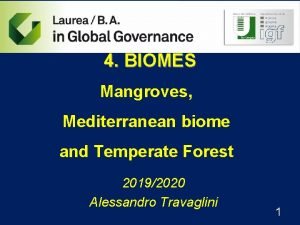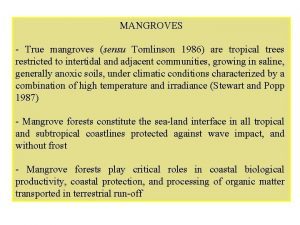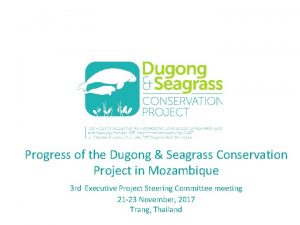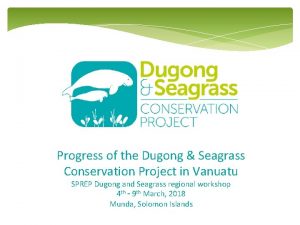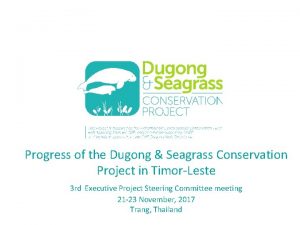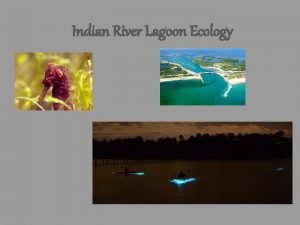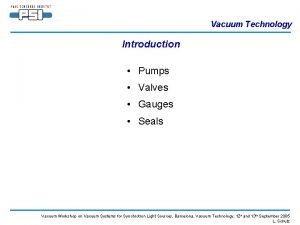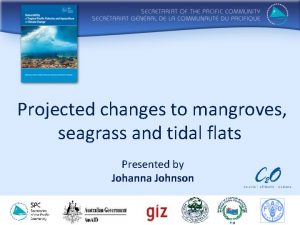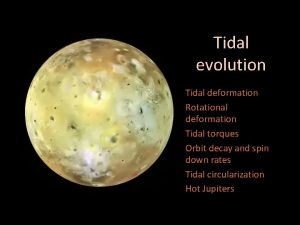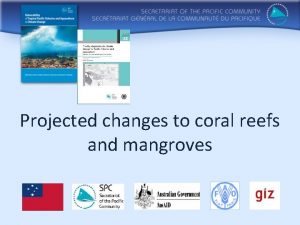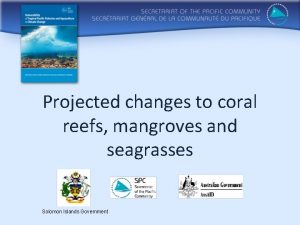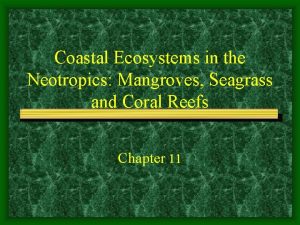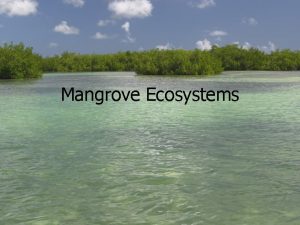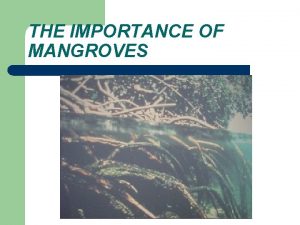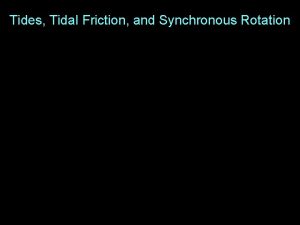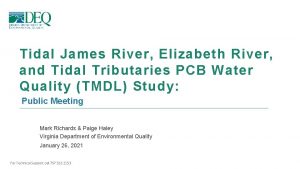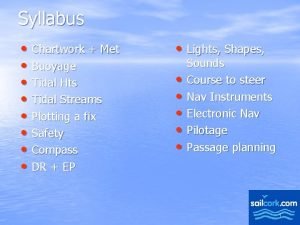Projected changes to mangroves seagrass and tidal flats

















- Slides: 17

Projected changes to mangroves, seagrass and tidal flats Presented by Johanna Johnson

Authors This presentation is based on Chapter 6 ‘Vulnerability of mangroves, seagrasses and intertidal flats in the tropical Pacific to climate change’ in the book Vulnerability of Tropical Pacific Fisheries and Aquaculture to Climate Change, edited by JD Bell, JE Johnson and AJ Hobday and published by SPC in 2011. The authors of Chapter 6 are: Michelle Waycott, Len J Mc. Kenzie, Jane E Mellors, Joanna C Ellison, Marcus T Sheaves, Catherine Collier, Anne-Maree Schwarz, Arthur Webb, Johanna E Johnson and Claude E Payri


Coastal habitats: role • Mangroves, seagrasses and intertidal flats provide nursery and feeding areas for coastal fish and shellfish • Targeted invertebrates reside permanently in seagrasses (e. g. sea cucumbers and molluscs) • Maintaining these habitats is critical for coastal fisheries (e. g. 3, 550 tonnes of inter/subtidal invertebrates are harvested per year in Fiji)

Coastal habitats: role mangroves seagrasses

Coastal habitats: Fiji • Large areas of mangroves (425 km 2 ) and seagrass (16. 5 km 2 ) • Documented relationship between rainfall patterns and mangrove reproductive success • One of few places deep seagrasses have been reported, at Great Sea Reef • Provide over 17, 000 tonnes of fish each year

Existing threats • Poor catchment management – transport of terrestrial sediments, nutrients and pesticides +SST • Direct removal and/or damage of mangroves and seagrass • Sand mining impacts on intertidal flats • Natural disturbances

Projected climate change 1980– 1999 average 2035 A 2 2050 A 2 2100 A 2 Air temperature (°C) 27. 4 +0. 5 to +1. 0 to +1. 5 +2. 5 to +3. 0 Sea surface temperature (°C) 27. 3 +0. 7 to +0. 8 +1. 2 to +1. 6 +2. 2 to +2. 7 +5 to +20 +10 to +20 -5 to -20 Rainfall: equatorial (%) Rainfall: subtropics (%) n/a Sea level (cm) +6 a +20 to +30 Ocean p. H (units) 8. 1 -0. 1 Tropical cyclones 9 a = since 1960 +70 to +110 -0. 2 +90 to +140 -0. 3 Number of tropical cyclones may decrease but likely to be more intense

Vulnerability: mangroves • Most vulnerable to: – sea-level rise – decreasing rainfall – increasing cyclone intensity • Ability to adapt by migrating landward as sea-level rises but human barriers may constrain movement • Overall moderate vulnerability to climate change

Vulnerability: seagrasses • Most vulnerable to: – increasing air and sea temperatures – changed rainfall patterns (increasing terrestrial sediment and nutrient inputs) – more intense cyclones and storms • Seagrasses in estuaries, fringing reefs and lagoon habitats will be most impacted • Limited ability to adapt • Overall moderate vulnerability to climate

Vulnerability: intertidal flats • Most vulnerable to sea-level rise • Ability to adapt by migrating landward as sealevel rises but human barriers and narrow atolls may constrain this • Overall low–moderate vulnerability to climate change

Overall vulnerability Sea surface Solar temperature radiation Ocean chemistry Cyclones & storms Rainfall patterns Sea level Nutrients Low High Low Mangroves 2035 A 2 Very low Low Very low Moderate 2050 A 2 Very low Low Very low Moderate Very high Low 2100 A 2 Very low Low Very low Moderate Very high Low Seagrasses 2035 A 2 Moderate Very low Moderate Low 2050 A 2 Moderate Very low Moderate 2100 A 2 High Very low High Moderate Low Moderate

Projected habitat change in Fiji Loss of habitat area: from 425 km 2 (m) & 16. 5 km 2 (s) Year Scenario Mangrove area (%) Seagrass area (%) 2035 A 2 -10 < -5 2050 A 2 -50 -5 to -10 2100 A 2 -60 -10 to -20

Vulnerable PICTs CNMI, FSM, Fiji, French Polynesia, Guam, Kiribati, New Caledonia, Palau, PNG, Samoa, Solomon Islands, Tonga, Vanuatu

Key adaptations 1. Build resilience of coastal habitats by addressing existing threats: – Integrated catchment management – Foster the care of coastal fish habitats – Manage and restore coastal vegetation 2. New measures to allow future adaptation: – Provide for landward migration of coastal fish habitats

Conclusions • Mangroves, seagrasses and intertidal flats (with coral reefs) support important coastal fisheries in Fiji • Coastal habitats in Fiji are expected to decline in area due to climate change • Acting now to manage existing threats and allow for future adaptation is vital for these habitats • Information on the distribution, diversity and area of these habitats, and future changes is a critical gap • Coastal fisheries that depend on these habitats will be impacted as these habitats degrade

Thank you j. johnson@c 2 o. net. au
 Projected and non projected aids
Projected and non projected aids Introduction of mangroves
Introduction of mangroves Mangroves biomes
Mangroves biomes Tomlinson 1986
Tomlinson 1986 Dugong and seagrass conservation project
Dugong and seagrass conservation project Dugong and seagrass conservation project
Dugong and seagrass conservation project Dugong
Dugong Solfege with sharps and flats
Solfege with sharps and flats What are elements of drama
What are elements of drama White mangrove
White mangrove Parallel key signatures
Parallel key signatures Pump of the volume
Pump of the volume Sancar flats
Sancar flats Forum flats
Forum flats Cape flats nature reserve
Cape flats nature reserve Most english families live in a
Most english families live in a Cape flats dune strandveld
Cape flats dune strandveld Changes in latitudes, changes in attitudes meaning
Changes in latitudes, changes in attitudes meaning


